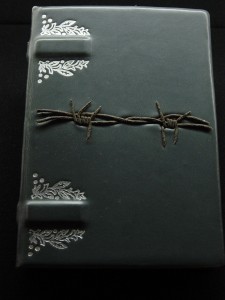anatol girs and “we were in auschwitz” by siedlecki, olszewski, borowski
Written by Janusz Nel Siedlecki, Krystyn Olszewski, and Tadeusz Borowski but widely attributed to Borowski (a note in Postal indiscretions: The Correspondence of Tadeusz Borowski, edited by Tadeusz Drewnowski and translated by Alicia Nitecki states that Borowski became “not only the author of the few stories for which he is known, but also the author of texts based on the other people’s accounts, co-author of most of the other stories, and also of the editing work (preface, dictionary, forewords to the stories, etc.)”), We Were in Auschwitz (also translated by Nitecki) was largely the brainchild of Anatol Girs, a graphic artist and publisher who Borowski met in 1945 while both were imprisoned in Dachau (Prior to being moved to Dachau, Girs, like Borowski, was also imprisoned in Auschwitz) and with whom Borowski worked at the Polish Red Cross in Munich immediately after the war. It was Girs who encouraged Borowski, known primarily as a poet, to write prose (his stark and wrenching poems, many of which were written at Auschwitz, unfortunately remain unpublished in an English translation although some can be found online).
 We Were in Auschwitz (Byliśmy w Oświęcimiu) was published in 1946 in Munich by Girs’ Oficyna Warszawska na Obczyznie. His evocative design for the cover reproduced the prison stripes of the camp uniforms and, incredibly, some unknown quantity of copies were actually bound with fabric from concentration camp uniforms themselves (a 2002 exhibit at Yale University on the work of Girs curated by Jae Jennifer Rossman displayed two such copies owned by Girs’ daughter Barbara). The copy on the left is in the collection on Professor Nitecki. The red triangle denotes, in the classification system used at Auschwitz and elsewhere, a “political” prisoner, (meaning almost certainly a Polish national); the number 6643 was the actual camp number of Janusz Siedlecki. The title page prominently lists the camp number of each author next to his name, Borowski’s, 119198, being the highest. Incidentally, the English translation by Nitecki published by Welcome Rain in 2000 faithfully reproduces the original cover. But, perhaps even more gut-wrenching than the copies bound in fabric from camp uniforms is Girs’ personal copy, also in the Yale exhibit (from the collection of Barbara Girs), hand bound in leather cut from an SS officer’s coat and embellished front and back with a strand of barbed wire and embossed on the spine with the image of a cracked skull.
We Were in Auschwitz (Byliśmy w Oświęcimiu) was published in 1946 in Munich by Girs’ Oficyna Warszawska na Obczyznie. His evocative design for the cover reproduced the prison stripes of the camp uniforms and, incredibly, some unknown quantity of copies were actually bound with fabric from concentration camp uniforms themselves (a 2002 exhibit at Yale University on the work of Girs curated by Jae Jennifer Rossman displayed two such copies owned by Girs’ daughter Barbara). The copy on the left is in the collection on Professor Nitecki. The red triangle denotes, in the classification system used at Auschwitz and elsewhere, a “political” prisoner, (meaning almost certainly a Polish national); the number 6643 was the actual camp number of Janusz Siedlecki. The title page prominently lists the camp number of each author next to his name, Borowski’s, 119198, being the highest. Incidentally, the English translation by Nitecki published by Welcome Rain in 2000 faithfully reproduces the original cover. But, perhaps even more gut-wrenching than the copies bound in fabric from camp uniforms is Girs’ personal copy, also in the Yale exhibit (from the collection of Barbara Girs), hand bound in leather cut from an SS officer’s coat and embellished front and back with a strand of barbed wire and embossed on the spine with the image of a cracked skull. 
Very special thanks to Alicia Nitecki, Jae Jennifer Rossman and Barbara Girs.

